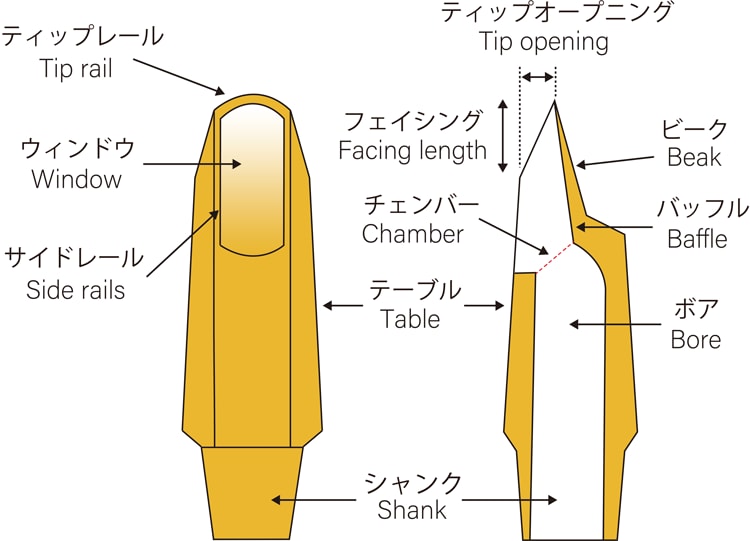The mouthpiece is an important part in creating sound production. You can play a variety of tones by changing the type of mouthpiece.
What is a mouthpiece?

A mouthpiece is the part that is attached to the cork part of the neck. A reed ligature is attached to the mouthpiece.
Materials of Mouthpiece
A mouthpiece is made of various materials, which are determined by the tone you want, music genre, and compatibility with your reed.
-

Hard Rubber
Hard rubber is a mixture of natural rubber and sulfur heated and hardened. It is also called ebonite. It is the most popular material because it has a warm tone and a comfortable touch.
- Major Brands
- Selmer, Vandoren, Meyer, Theo Wanne, Yanagisawa
-

Metal
Metal is a popular choice for those who play jazz and rock music. It features a bright metallic sound. Metal can be made of a variety of materials, including brass, stainless steel, and bronze. The tone and feel differ depending on the surface finish, which is called the plating.
- Major Brands
- Otto Link, Yanagisawa, Theo Wanne, Wood Stone
-

Plastic
Plastic is a lightweight and strong material. Since the production cost is low, many starter kits include a plastic mouthpiece.
- Major Brands
- YAMAHA, Syos
The Structure of Saxophone Mouthpiece
The most important factor that determines the tone and feel of a mouthpiece is the internal structure as well as the material. A very small difference can make a big difference in tone and feel.

Tip Opening
The tip opening is the distance (opening) between the reed and the mouthpiece tip. The wider the tip opening, the louder and fuller the sound, but the more breath is required. If the opening is more narrow, it produces a brighter sound and requires less breath. The way the tip opening gauges are indicated can vary from one brand to another. Mostly, the gauges are indicated by numbers or letters: “C* (C star)”, “C** (C two stars)”, “5MM”, etc.
Facing
Facing is the length between the mouthpiece tip and the point where the reed touches the mouthpiece. This is where the reed vibrates and it changes the blowing feel and the sound response.
There are mainly three facing types: short, medium, and long. The shorter the facing, the brighter and clearer the sound. The longer the facing, the darker and softer the sound. In addition to the facing length, the facing curve and the shape will also affect the sound.
Baffle
Baffle is the part of the mouthpiece located just behind the reed. It is the surface where the air is vibrated by the reed strikes directly, so it is an important element in creating the sound.
The sound can be changed by adjusting the height of the baffle.
A low step baffle requires more breath while a high step baffle is a mouthpiece that produces a direct sound without resistance when blowing. However, a high step baffle is usually difficult to control, but it’s easier to add techniques such as bending and growling.

There are several shapes of baffles, and the most common types are as follows:
| Straight | Step | Circular |
|---|---|---|
 |
 |
 |
| Dark and soft sound | Well-balanced tone | Metallic and aggressive sound |
Chamber
The chamber is the internal part of the bore where it is located just around the entrance of the cork when the neck is assembled. Since it is the part where the player’s breath enters the instrument, it affects the tone.

The size of the chamber has a significant effect especially on the brightness of the sound. The larger the diameter of the chamber, the darker the sound, and the smaller the diameter, the brighter and more brilliant the sound.
Conclusion
In this article, we introduced mouthpieces that greatly affect the tone of a saxophone. Various factors can change the sound. So for example, a larger chamber does not necessarily mean a darker sound, but it depends on the shape of the baffle in particular.
You can combine the mouthpiece with different reeds or ligatures to create various combinations of sound. The world of saxophone mouthpieces is so deep, isn’t it?













